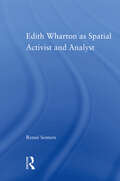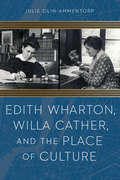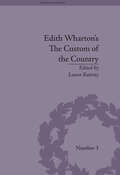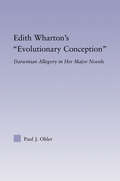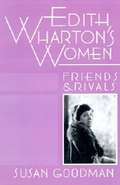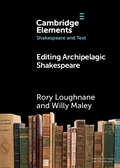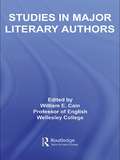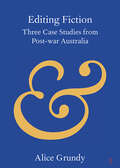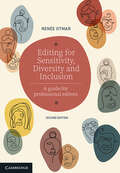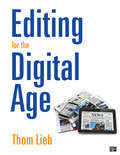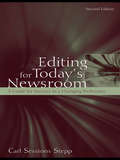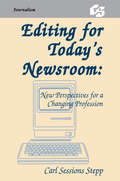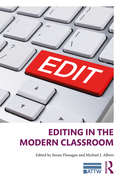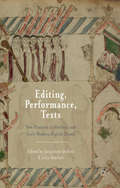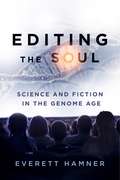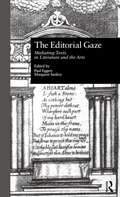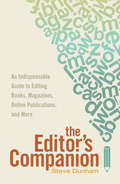- Table View
- List View
Edith Wharton as Spatial Activist and Analyst (Studies in Major Literary Authors)
by Reneé SomersBecause she devoted much of her life to exploring the relationships that exist between people and their built environment, Edith Wharton developed a set of philosophies that she expressed in many arenas, including interior design, architecture, and landscaping. Her theories of space were practiced and materially executed, in addition to being expressed in her writing. This book explores Wharton's theories of space in Newport, Rhode Island during the Gilded Age when the town was transformed from a rustic seaport to a playground for the fabulously wealthy. The built environment played a pivotal role as social, economic and personal conflicts were enacted among private and public spaces. As a cultural worker and as an author, Wharton stood squarely in the middle of these conflicts and directly participated in them. Accordingly, the book shows Wharton in a new light by exploring texts such as The Decoration of Houses and The House of Mirth as well as by examining the architecture and aesthetics of three of Wharton's primary homes.
Edith Wharton in Context
by Laura RattrayEdith Wharton was one of America's most popular and prolific writers, becoming the first woman to win the Pulitzer Prize for Fiction in 1921. In a publishing career spanning seven decades, Wharton lived and wrote through a period of tremendous social, cultural, and historical change. Bringing together a team of international scholars, this volume provides the first substantial text dedicated to the various contexts that frame Wharton's remarkable career. Each essay offers a clearly argued and lucid assessment of Wharton's work as it relates to seven key areas: life and works, critical receptions, book and publishing history, arts and aesthetics, social designs, time and place, and literary milieux. These sections provide a broad and accessible resource for students coming to Wharton for the first time while offering scholars new critical insights. Of interest to English and American studies departments, the volume will also appeal to researchers in gender studies, film studies, book history, art history, and transatlantic studies.
Edith Wharton, Willa Cather, and the Place of Culture
by Julie Olin-AmmentorpEdith Wharton and Willa Cather wrote many of the most enduring American novels from the first half of the twentieth century, including Wharton’s The House of Mirth, Ethan Frome, and The Age of Innocence, and Cather’s O Pioneers!, My Ántonia, and Death Comes for the Archbishop. Yet despite their perennial popularity and their status as major American novelists, Wharton (1862–1937) and Cather (1873–1947) have rarely been studied together. Indeed, critics and scholars seem to have conspired to keep them at a distance: Wharton is seen as “our literary aristocrat,” an author who chronicles the lives of the East Coast, Europe-bound elite, while Cather is considered a prairie populist who describes the lives of rugged western pioneers. These depictions, though partially valid, nonetheless rely on oversimplifications and neglect the striking and important ways the works of these two authors intersect. The first comparative study of Edith Wharton and Willa Cather in thirty years, this book combines biographical, historical, and literary analyses with a focus on place and aesthetics to reveal Wharton’s and Cather’s parallel experiences of dislocation, their relationship to each other as writers, and the profound similarities in their theories of fiction. Julie Olin-Ammentorp provides a new assessment of the affinities between Wharton and Cather by exploring the importance of literary and geographic place in their lives and works, including the role of New York City, the American West, France, and travel. In doing so she reveals the two authors’ shared concern about the culture of place and the place of culture in the United States.
Edith Wharton's The Custom of the Country: A Reassessment (Gender and Genre #3)
by Laura RattrayBringing together leading Wharton scholars from Europe, and North America, this volume offers the first ever collection of essays on Edith Wharton's 1913 tour de force, The Custom of the Country.
Edith Wharton's Evolutionary Conception: Darwinian Allegory in the Major Novels (Studies in Major Literary Authors)
by Paul J. OhlerEdith Wharton's "Evolutionary Conception" investigates Edith Wharton's engagement with evolutionary theory in The House of Mirth, The Custom of the Country, and The Age of Innocence. The book also examines The Descent of Man, The Fruit of the Tree, Twilight Sleep, and The Children to show that Wharton's interest in biology and sociology was central to the thematic and formal elements of her fiction. Ohler argues that Wharton depicts the complex interrelations of New York's gentry and socioeconomic elite from a perspective informed by the main concerns of evolutionary thought. Concentrating on her use of ideas she encountered in works by Darwin, Herbert Spencer, and T.H. Huxley, his readings of Wharton's major novels demonstrate the literary configuration of scientific ideas she drew on and, in some cases, disputed. R.W.B. Lewis writes that Wharton 'was passionately addicted to scientific study': this book explores the ramifications of this fact for her fictional sociobiology. The book explores the ways in which Edith Wharton's scientific interests shaped her analysis of class, affected the formal properties of her fiction, and resulted in her negative valuation of social Darwinism.
Edith Wharton's Women: Friends and Rivals
by Susan GoodmanFascinating literary analysis of Wharton's work, as well offering eye-opening insights into the period in which she lived. A few of the endnotes are missing, but nothing critical.
Editing Archipelagic Shakespeare (Elements in Shakespeare and Text)
by Rory Loughnane Willy MaleyEditing Archipelagic Shakespeare is a study of the power of names; more specifically, it is about the power of naming, asking who gets to choose names, for what reason, and to what effect. Shakespeare assigns names to over 1,200 characters and countless more sites and places, and these names, or versions of these names, have become familiar to generations of playgoers and play-readers. And because of their familiarity, Shakespeare's names, most frequently anglicized versions of non-English names, have been accepted and repeated without further consideration. Approaching names from an archipelagic perspective, and focusing upon how Irish, Scottish, and Welsh characters and places are written by Shakespeare and treated by editors, this Element offers an expansive, and far-reaching, case study for non-anglophone and global studies of Shakespeare, textual scholarship, and early modern drama.
Editing Early Modern Women
by Ross, Sarah C. E. and Salzman, Paul Ross, Sarah C. E. Paul SalzmanThis collection of new essays is a comprehensive exploration of the theoretical and practical issues surrounding the editing of texts by early modern women. The chapters consider the latest developments in the field and address a wide range of topics, including the 'ideologies' of editing, genre and gender, feminism, editing for student or general readers, print publishing, and new and possible future developments in editing early modern writing, including digital publishing. The works of writers such as Queen Elizabeth I, Mary Wroth, Anne Halkett, Katherine Philips and Katherine Austen are examined, and the issues discussed are related to the ways editing in general has evolved in recent years. This book offers readers an original overview of the central issues in this growing field and will interest students and scholars of early modern literature and drama, textual studies, the history of editing, gender studies and book history.
Editing Emily Dickinson: The Production of an Author (Studies in Major Literary Authors)
by Lena ChristensenEditing Emily Dickinson considers the processes through which Dickinson's work has been edited in the twentieth century and how such editorial processes contribute specifically to the production of Emily Dickinson as author. The posthumous editing of her handwritten manuscripts into the conventions of the book and the electronic archive has been informed by editors' assumptions about the literary work; at stake is fundamentally what a Dickinson poem may be, or, rather, how we may approach such an object.
Editing Fiction: Three Case Studies from Post-war Australia (Elements in Publishing and Book Culture)
by Alice GrundyEditing Fiction considers the collaborative efforts of literary production as well as editorial practice in its own right, using case studies by Australian novelists Jessica Anderson, Thea Astley and Ruth Park. An emphasis on collaboration is necessary because literary criticism often takes books as finite, discrete works rather than the result of multiple contributors, engaged to differing degrees. The editorial process always involves a negotiation over edits for the sake of the work, taking its potential reception or projected sales into account. Through examination of the archives, this Element shows that editing can be formative, limiting, commercially directed, a literary collaboration – or a mix of all these interventions. For editors and scholars alike, the Element examines practices of the recent past, seeking to determine the responsibilities of editors and publishers to authors, the text itself and to society; and the interrelation of editorial work, social conditions and market forces.
Editing for Sensitivity, Diversity and Inclusion: A Guide for Professional Editors
by Renée OtmarEditors should approach their work with an informed worldview, ensuring that harmful stereotypes, cultural insensitivities and inaccurate information are avoided. Knowing how to do so – and what to replace them with – can be tricky. Editing for Sensitivity, Diversity and Inclusion is a guide for professional editors, providing evidence-based definitions, recommendations and support for emerging and experienced editors working with fiction and non-fiction genres. Part One introduces the foundations of professional editing and what editors need to know to conduct themselves well in professional contexts. Part Two applies this knowledge to professional practice, covering topics such as plagiarism, literary and cultural appropriation, critical appraisal, and developing a workplace policy and style guide. Part Three explores an extensive range of topics relevant to editing for sensitivity, diversity and inclusion, including addiction, dependence and recovery; class and socio-economic status; indigeneity; religious, spiritual and other belief systems; sex and gender identity; and trauma and torture.
Editing for the Digital Age (20160101 #05 College/higher education)
by Thom LiebA Balanced Approach for the Modern Writer and Editor Whether working in a traditional newsroom or as a one-person blogging operation, every good writer needs to become his or her own best editor. Editing for the Digital Age provides editors and writers with the tools necessary to ensure that published material is accurate, readable, and complete. The book provides guidance in copy editing fundamentals, including correcting grammar, conforming the writing to a style guide, and revising material so that it is tightly written and clear. The text is designed for today’s digital publishing landscape and addresses the many issues writers and editors now face on a daily basis—handling legal issues such as liability, copyright, and libel; writing headlines that will attract readers; creating multimedia packages to support an article or post; and using various forms of social media to curate content and connect with audience members. Chapters focus on key areas and themes for editing in the digital age, and "Write Right" writing and grammar exercises are woven into every chapter to progressively build students’ editing skills.
Editing for the Digital Age (20160101 #05 College/higher education)
by Thom LiebA Balanced Approach for the Modern Writer and Editor Whether working in a traditional newsroom or as a one-person blogging operation, every good writer needs to become his or her own best editor. Editing for the Digital Age provides editors and writers with the tools necessary to ensure that published material is accurate, readable, and complete. The book provides guidance in copy editing fundamentals, including correcting grammar, conforming the writing to a style guide, and revising material so that it is tightly written and clear. The text is designed for today’s digital publishing landscape and addresses the many issues writers and editors now face on a daily basis—handling legal issues such as liability, copyright, and libel; writing headlines that will attract readers; creating multimedia packages to support an article or post; and using various forms of social media to curate content and connect with audience members. Chapters focus on key areas and themes for editing in the digital age, and "Write Right" writing and grammar exercises are woven into every chapter to progressively build students’ editing skills.
Editing for Today's Newsroom: A Guide for Success in a Changing Profession
by Carl Sessions SteppEditing for Today's Newsroom provides training, support and advice for prospective news editors. Through history, analyses, and anecdotes, this book offers a solid grounding to prepare potential editors for the full range of their responsibilities in today's newsrooms: developing ideas; evaluating and editing copy; working with writers; determining what is news; understanding presentation and design; directing news coverage; managing people; making decisions under pressure; and coping with a variety of ethical, legal, and professional considerations, all while operating in today’s multimedia, multiplatform news arena. Author Carl Sessions Stepp focuses on editors as newsroom decision makers and quality controllers; accordingly, the book features strategies and techniques for coping with a broad spectrum of editing duties. Covering basic and advanced copyediting skills, it also provides intellectual context to the editor's role, critically examining the history of editing and the changing job of the contemporary editor.
Editing for Today's Newsroom: New Perspectives for a Changing Profession
by Carl Sessions SteppThrough anecdotes, history, and analysis, this book offers sound advice to prepare prospective editors for the full range of their duties: editing copy, determining what is news, understanding graphics and design, directing coverage, managing people, and coping with a spectrum of ethical and legal dilemmas.
Editing in the Modern Classroom (ATTW Series in Technical and Professional Communication)
by Suzan Flanagan Michael J. AlbersEditing in the Modern Classroom is a research‐based collection that defines the current state of technical editing pedagogy and plots a potential roadmap for its future. It examines current academic and professional editing practices, the global and corporate contexts of technical communication programs, and the role of new challenges such as content management in order to assess what should be expected from editing courses today and how instructors can best structure their courses to meet these expectations. It provides a research foundation to determine where changes are needed, and points to areas where additional research must be done to support further curricular and pedagogical innovations. Editing in the Modern Classroom challenges instructors to look deeper at the pedagogical aspects of what makes up an effective technical editing course at undergraduate and graduate levels and provides them with comprehensive and evidence-based resources to design and teach these courses.
Editing Modernity
by Dean IrvineThe period between 1916 and 1956 was a unique interval in the history of Canadian publishing. During this period not only were a significant number of non-commercial literary, arts, and cultural magazines established, but it also happened that an unprecedented number of those involved in the creation and subsequent editing of this new type of magazine - the little magazine - were women. Based on extensive new archival and literary historical research, Editing Modernity examines these Canadian women writers and editors and their role in the production and dissemination of modernist and leftist little magazines.At once a history of literary women and of the emergent formations and conditions of cultural modernity in Canada, Irvine's study relates women's editorial work and poetry to a series of crises and transitions in modernist and leftist magazine communities, to the public hearings and published findings of the Massey Commission of 1949-51, and to the later development of feminist literary magazines and editorial collectives during the 1970s and 1980s. Writers and editors examined in this study include Dorothy Livesay, Anne Marriott, Floris McLaren, P.K. Page, Miriam Waddington, Flora Macdonald Denison, Florence Custance, Catherine Harmon, Aileen Collins, and Margaret Fairley.
Editing Nineteenth-Century Fiction: Papers given at the thirteenth annual Conference on Editorial Problems, University of Toronto, 4-5 November 1977 (Routledge Library Editions: The Nineteenth-Century Novel #29)
by Jane MillgateFirst published in 1978, this collection of papers, first presented at the thirteenth annual Conference on Editorial Problems in 1977, focuses on the editing of nineteenth-century fiction. Four of the papers are devoted to single authors – Dickens, Thackeray, Hardy and Zola – while the fifth takes its principle examples from Hawthorne, Twain and Crane. Looking at a range of works from English, American and French literature, this volume demonstrates the number of different attitudes that exist towards the editorial process as well as the different ambitions for the texts that scholars seek to produce. This book will be of interest to those studying and editing nineteenth-century literature.
Editing, Performance, Texts
by Jacqueline Jenkins Julie SandersThe essays in this volume challenge current 'givens' in medieval and early modern research around periodization and editorial practice. They showcase cutting-edge research practices and approaches in textual editing, and in manuscript and performance studies to produce new ways of reading and working for students and scholars.
Editing the Soul: Science and Fiction in the Genome Age (AnthropoScene: The SLSA Book Series #2)
by Everett HamnerPersonal genome testing, gene editing for life-threatening diseases, synthetic life: once the stuff of science fiction, twentieth- and twenty-first-century advancements blur the lines between scientific narrative and scientific fact. This examination of bioengineering in popular and literary culture shows that the influence of science on science fiction is more reciprocal than we might expect.Looking closely at the work of Margaret Atwood, Richard Powers, and other authors, as well as at film, comics, and serial television such as Orphan Black, Everett Hamner shows how the genome age is transforming both the most commercial and the most sophisticated stories we tell about the core of human personhood. As sublime technologies garner public awareness beyond the genre fiction shelves, they inspire new literary categories like “slipstream” and shape new definitions of the human, the animal, the natural, and the artificial. In turn, what we learn of bioengineering via popular and literary culture prepares the way for its official adoption or restriction—and for additional representations. By imagining the connections between emergent gene testing and editing capacities and long-standing conversations about freedom and determinism, these stories help build a cultural zeitgeist with a sharper, more balanced vision of predisposed agency.A compelling exploration of the interrelationships among science, popular culture, and self, Editing the Soul sheds vital light on what the genome age means to us, and what’s to come.
Editing the Soul: Science and Fiction in the Genome Age (AnthropoScene)
by Everett HamnerPersonal genome testing, gene editing for life-threatening diseases, synthetic life: once the stuff of science fiction, twentieth- and twenty-first-century advancements blur the lines between scientific narrative and scientific fact. This examination of bioengineering in popular and literary culture shows that the influence of science on science fiction is more reciprocal than we might expect.Looking closely at the work of Margaret Atwood, Richard Powers, and other authors, as well as at film, comics, and serial television such as Orphan Black, Everett Hamner shows how the genome age is transforming both the most commercial and the most sophisticated stories we tell about the core of human personhood. As sublime technologies garner public awareness beyond the genre fiction shelves, they inspire new literary categories like “slipstream” and shape new definitions of the human, the animal, the natural, and the artificial. In turn, what we learn of bioengineering via popular and literary culture prepares the way for its official adoption or restriction—and for additional representations. By imagining the connections between emergent gene testing and editing capacities and long-standing conversations about freedom and determinism, these stories help build a cultural zeitgeist with a sharper, more balanced vision of predisposed agency.A compelling exploration of the interrelationships among science, popular culture, and self, Editing the Soul sheds vital light on what the genome age means to us, and what’s to come.
Editing Women's Writing, 1670-1840 (Chawton Studies in Scholarly Editing)
by Amy Culley Anna M. FitzerThis edited volume is the first to reflect on the theory and practice of editing women’s writing of the 18th century. The list of contributors includes experts on the fiction, drama, poetry, life-writing, diaries and correspondence of familiar and lesser known women, including Jane Austen, Delarivier Manley, Eliza Haywood and Mary Robinson. Contributions examine the demands of editing female authors more familiar to a wider readership such as Elizabeth Montagu, Mary Robinson and Helen Maria Williams, as well as the challenges and opportunities presented by the recovery of authors such as Sarah Green, Charlotte Bury and Alicia LeFanu. The interpretative possibilities of editing works published anonymously and pseudonymously are considered across a range of genres. Collectively these discussions examine the interrelation of editing and textual criticism and show how new editions might transform understandings not only of the woman writer and women’s literary history, but also of our own editorial practice.
The Editor Function: Literary Publishing in Postwar America
by Abram FoleyOffering the everyday tasks of literary editors as inspired sources of postwar literary history Michel Foucault famously theorized &“the author function&” in his 1969 essay &“What Is an Author?&” proposing that the existence of the author limits textual meaning. Abram Foley shows a similar critique at work in the labor of several postwar editors who sought to question and undo the corporate &“editorial/industrial complex.&” Marking an end to the powerful trope of the editor as gatekeeper, The Editor Function demonstrates how practices of editing and publishing constitute their own kinds of thought, calling on us to rethink what we read and how.The Editor Function follows avant-garde American literary editors and the publishing practices they developed to compete against the postwar corporate consolidation of the publishing industry. Foley studies editing and publishing through archival readings and small press and literary journal publishing lists as unique sites for literary inquiry. Pairing histories and analyses of well- and lesser-known figures and publishing formations, from Cid Corman&’s Origin and Nathaniel Mackey&’s Hambone to Dalkey Archive Press and Semiotext(e), Foley offers the first in-depth engagement with major publishing initiatives in the postwar United States.The Editor Function proposes that from the seemingly mundane tasks of these editors—routine editorial correspondence, line editing, list formation—emerge visions of new, better worlds and new textual and conceptual spaces for collective action.
The Editorial Gaze: Mediating Texts in Literature and the Arts (Comparative Literature and Cultural Studies #2)
by Paul Eggert Margaret SankeyThis collection of original essays brings international and multidisciplinary perspectives to the problem of how to understand and practice editorial mediation: How does editing alter what it seeks to represent? How does it condition the relationship between texts and readers? The different concerns shared by editors of a variety of genres, literary and otherwise, emerge here as constructive new approaches to the theory and practice of editing are explored. The essays make a concerted attempt to assess the implications of postmodern thought on one of the oldest and most fundamental cultural activities, editing The section on theory covers such important subjects as editorial responsibility, the death of the author, and the nature of the authorial voice. The practice section covers actual editing situations in various literary areas and in musicology, recorded music, and the preservation of oral literature. The multidisciplinary volume will find its readers among students of textual criticism, literature, music, and folklore as well as any readers of postmodern criticism.
The Editor's Companion: An Indispensable Guide to Editing Books, Magazines, Online Publications, and Mor e
by Steve DunhamExcel at editing! The editor's job encompasses much more than correcting commas and catching typos. Your chief mission is to help writers communicate effectively--which is no small feat. Whether you edit books, magazines, newspapers, or online publications, your ability to develop clear, concise, and focused writing is the key to your success. The Editor's Companion is an invaluable guide to honing your editing skills. You'll learn about editing for: CONTENT: Analyze and develop writing that is appealing and appropriate for the intended audience. FOCUS: Ensure strong beginnings and satisfying endings, and stick with one subject at a time. PRECISE LANGUAGE: Choose the right words, the right voice, and the right tense for every piece. GRAMMAR: Recognize common mistakes in punctuation, parts of speech, and sentence structure--and learn how to avoid them. You'll also find valuable editing resources and checklists, advice on editorial relationships and workflow, and real-life samples of editing with explanations of what was changed and why. The Editor's Companion provides the tools you need to pursue high quality in editing, writing, and publishing--every piece, every time.
